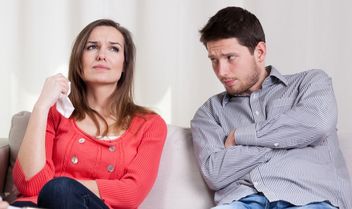 By Emily Kircher-Morris, LPC A child keeps kicking his brother's car seat, even after his mom has asked him to stop. The class clown keeps interrupting the teacher with off-topic and mildly inappropriate comments. A preteen girl crumples her homework and dramatically hides her face in her arms on her desk. A young boy has a meltdown because he is told they are having cookies instead of ice cream for dessert. When trying to figure out what is behind these problematic behaviors, parents and teachers may come to the conclusion the child is engaged in negative attention-seeking. They come to the conclusion that the best response is to ignore or give a negative consequence for the behavior. Many people feel that attention-seeking behavior is a negative trait. The attention the child is seeking is unearned and the result of a child being overly emotional and dramatic. The reaction may be to ignore the behavior or even give a negative consequence to the child. I'd like to suggest a different way to look at attention-seeking behavior. If we consider all behavior to be communication and ask ourselves, "What is the child needing from this interaction?" we may find some ideas of how to handle the behavior. Let's reframe attention-seeking as reassurance-seeking. Their behavior is saying: Am I alone? Do you love me? Am I worthwhile? Even if I act this way, will you stick with me? We all need attention once in a while. We may seek it in positive ways, through accomplishments and helping others. The reassurance we get from those acknowledging us can keep us going. Sometimes kids don't have the language or emotional regulation skills to get their needs met in the most convenient way for us. But, when we remind ourselves the attention-seeking is really reassurance-seeking, we build our relationship with the child and can help them learn more appropriate ways to seek that reassurance from us in the future.
1 Comment
For example, my son refused to wear a bike helmet more than once. Instead of taking his bike away, he had to research and find information about the risks associated with bike helmet safety and regulations. It was time consuming. I had to help him through the process. It also kept him from his preferred activities, but, it was engaging. It allowed him to create new connections in his awareness of the topic. It was much more effective than me lecturing him, too. And when he was able to share his learning, he felt proud of his work instead of ashamed of his mistake.
The downside of restorative consequences it takes effort, time, and creativity on the part of the parent. However, the long-term benefit in learning and the relationship it fosters between you and your child will be worth the effort.  By Andrea Schramm, LPC Our emotions are a natural, powerful information gathering system allowing us to quickly gather information about our own experiences and those of the people around us. Emotions are part of our communication system and influence our social connections with others. Emotions are also physical. We all know the word “feeling” associated with our emotional experiences. So how do our emotions and our ability to understand and manage them connect us with others in both intimate and social relationships? How can we communicate successfully incorporating our emotions? Emotions inform communication. “I feel good…I don’t like her…Yes, I’d love to have dinner tonight…Yuk, I hate sushi.” These are all examples of how emotions inform. Emotional experiences are often connected to our past experiences, our learning history. We experience emotions associated with events we have at some point had before which form our emotional response: “The first time I ate sushi, it was disgusting. It makes me ‘feel’ sick.” We can become programmed to respond emotionally to experiences we’ve had previously. Here are some tips for communicating using emotionally informed behaviors:
Remember, emotions inform. Take some time to acknowledge and think about your own emotions. Why do you think you feel as you do? What past experiences formed the emotional responses you have? Learning to understand emotional responses can build a stronger sense of self and teach us to use emotions to build positive relationships with each other.  By Emily Kircher-Morris, LPC "Did you do your homework?" "Yes!" "Is your laundry in the basket?" "Yeah." "Is your room clean?" "Yep." How quickly those little impulsive lies fly! As parents, we are constantly checking and double checking on the tasks that are supposed to be completed. And, for some parents, we are consistently frustrated and challenged by the immediate dishonest response we receive. Why do kids lie? There are many reasons why a child will lie to a parent, but the simplest answer is this: They don't want to get in trouble! Then the child is caught in a double bind. They know they've lied, but what choices do they have now? They can tell the truth (and be reprimanded for lying) or they can keep up with the lie (and hope they don't get caught). Kids with executive functioning struggles and ADHD are notorious for these "speak before thinking" fibs. One simple communication tool that can help to reduce or eliminate the lying in these situations is a basic reframe of the question. Request the information in a way which a one-word answer and impulsive lie isn't an option. Instead of "Did you do your homework?" This easy change of phrase can slow down the quick response of a child trying to avoid getting in trouble. It causes them to pause and think, recognizing accountability is a key component of the request. Framing questions in this way gives your son or daughter a chance to reflect and say, "I can show you my math homework, but I still need to finish my science."
Some parents may balk. "Why can't they just be honest when I ask a simple question?" When executive functioning lags, the knee-jerk response lets out the lie before the prefrontal cortex has had a chance to process what is being asked. Parents are getting a response from the flight-fight-freeze control center (the amygdala) before the prefrontal cortex has even had enough time to figure out what the actual answer to the question is! Rephrase your question. Follow up with an accountability action. These simple steps will foster positive communication, improve your child's executive functioning skills, and reduce the stress of handling dishonesty in the parent-child relationship. By Caitlin Winkler, PLPC Becoming a more positive parent does not mean always looking on the bright side and sugar-coating life with your child. It doesn't have to be silly, corny, or uncomfortable. It also does not mean never telling your child "no." Again, there is a time and place for using these words and phrases. This style focuses your attention on the positive actions, behaviors, and thoughts your child exhibits more than the negative. It involves making positively-worded statements toward your child significantly more often than negatively worded statements. Using these toward your child encourages them to continue a wanted behavior and still maintains your authority. To break it down, positive parenting involves using positive praises and positive directives. Positive praises are used at any time. They are meant to reinforce wanted behaviors and words. Positive directives (or called positive opposites) teach your child what actions you are wanting them to have. Continuing the list from the previous post, here are six more ideas of how you can be a more positive parent to your son or daughter. 6. Be aware of positive opposites. Positive opposites teach your child what TO DO instead of limiting the message about what not to do. Instead of saying "Don't hit or kick other kids" the positive opposite would be "Keep your hands and feet to yourself." Another example would be, "Quit whining and fussing" turns into "Use your words." 7. Keep statements clear and concise. If you are giving a positively worded directive to your child, be clear about what is expected while keeping your directions from turning into a lecture. 8. Stick with it and be flexible. If this is new in your household, it may take some time for everyone to adjust. Keep working with your child and you will see them change as well as your relationship. And be flexible. Some kids are motivated by a simple "Great job cleaning your room today" while others need high-fives, positive praises, and other reinforcements. Think of what motivates your kid and use that. 9. When providing positive directives, keep your voice firm and calm. Communicate to your child you mean business while also being in control of your own words and actions. Lashing out in anger completely erases the positive message. Children learn by example, and it starts with the adults in his or her world. 10. Becoming a more positive parent seems to be geared toward younger children, however, this style can be used with older kids as well. Adjust as you see fit, but the basic ideas are the same! 11. Seek advice and help from friends, family, and professionals. No one is perfect and has this whole parenting thing figured out. It is a challenge! Reach out to people when you need some encouragement, tips, and help. Caitlin Winkler is a Provisionally Licensed Professional Counselor at Unlimited Potential Counseling & Education Center in O’Fallon. Caitlin is under the clinical supervision of Emily Kircher-Morris, LPC (MO #2012026754).
 By Caitlin Winkler, PLPC "Stop," "Don't," "No," and a list of similar words are common when correcting a child. At times, it may feel like these are the only words we know or that come out of our mouths. Every child is learning the do's and don'ts in life when they are growing up. "Stop pestering your sister," "Don't touch the hot stove," and "No yelling in the car," are all examples of basic skills we were taught. There is definitely a time and place for phrases like these, but all too often our parenting phrase repertoire mainly consists of statements telling our children what NOT to do. In the heat of the moment, it is easy to focus on what behavior you want to stop. In the long run it is not necessarily the best solution. By slightly altering our way of thinking and talking, we can help improve behavior and create a more positive environment. Think of the last thing you praised your child for doing or saying. Can you remember? Some people feel silly and robotic when praising children and this may be part of why we choose not to praise them enough. At first, especially if this is a new concept, it may feel just like that. Once you start seeing results, it will come more naturally and be more genuine. Here are the first five ideas to help you start this new style of parenting... 1. Find ANYTHING positive your child does or says and state out loud, with enthusiasm, how awesome it was. "Johnny, thank you so much for washing your hands!" or "I appreciate you arriving home before curfew, Bethany." This can especially important when you beginning this process. 2. Avoid saying "Good job" or another vague positive statement. Be specific about why you are proud of them. "Emily, you are doing a great job sharing your toys with Natalie!" 3. Use their name often when making your statement. This creates a sense of ownership and pride. 4. Show your excitement! Use your tone of voice, body language, eye contact, and actions to convey your message. Utilizing clapping, high-fives, fist bumps, affectionately squeezing a shoulder, telling everyone you meet what a great thing your child just did, or a secret handshake are a few examples of some simple tools. There are times where "throwing a party" is necessary to get the message across that the type of action or words they just had is exactly what you need from them. For example, if you are teaching responsibility by directing your child to clean up toys after playing and in the past this has been a battle, you would very enthusiastically clap, state positively worded phrases, and perhaps say "Wahoo!" or jump up and down when the child complies with your directions. For others on the outside looking in, you may look very silly, but when your child beams with pride and continues to pick up toys, it will be worth it! Get excited when your child does the right thing! 5. Make sure your positives outweigh your negatives. For every negatively worded statement, try to have ten positives. Again, even if it is a small thing, praise your child for making a great choice. Use these as a starting point for your communication with your child. Remember, these can work at any age. Stay tuned for more ideas on how to positively communicate your expectations to your child. Caitlin Winkler is a Provisionally Licensed Professional Counselor at Unlimited Potential Counseling & Education Center in O’Fallon. Caitlin is under the clinical supervision of Emily Kircher-Morris, LPC (MO #2012026754).
 By Emily Kircher-Morris, LPC As parents, we’ve all been there. Your child calls her sister a name, replies to you with a sarcastic tone of voice, or any other typical childish behavior that warrants an apology. “Now say you’re sorry,” we tell them. Embarrassed, or angry, or exasperated, we get an apology: A muttered “Sorry” and a quick exit. Apologies are hard for all of us. How can we help our children grow through the process of making an apology? How can we help them know that a one-word apology doesn’t actually make a difference when it is nothing more than a platitude? How can we help them experience the relief and reprieve of admitting a wrong and the benefit it gives both people involved? Part of the reason that making an apology is so difficult for individuals of all ages is because it requires us to show ultimate vulnerability. We have to admit that what we did was wrong and we recognize the harm it caused. Any apology with less than full acceptance of responsibility of wrong-doing is ineffective. Many of the children and teens I work with in my practice are perfectionists. This makes recognizing a mistake and apologizing for it especially difficult. Not only do they have to admit their mistake to themselves, they also must then publicly request forgiveness. This skill is an important in overcoming perfectionism: Helping them recognize that it is okay to make mistakes and push through the uncomfortable feeling of admitting their mistakes is a big part of overcoming perfectionism. Here are the four steps that you can walk your child through to make an effective apology.
You may have to work with your child on one step at a time. I have found the third step (recognizing another’s emotions) is often the most difficult for kids to do. Tweak these steps to make them work for your child. For example, you might ask your child to write his or her apology if speaking it aloud is too difficult or emotional. Or, you could allow your child to do the first two steps to the person that has been wronged and simply talk about the second two steps privately, until they are ready to integrate them into the apology. Remember that apologies also don’t necessarily have to be immediate; if your child’s emotions are too strong just after a situation to say they are sorry, give them time to cool down and process. Just don’t forget to follow up. Making an effective apology is more than good manners. When done appropriately, effective apologies build emotional awareness, increase the ability to show vulnerability within relationships, and teach children that when we place others’ emotions first, we have stronger relationships. |
Archives
August 2021
Categories
All
|

 RSS Feed
RSS Feed